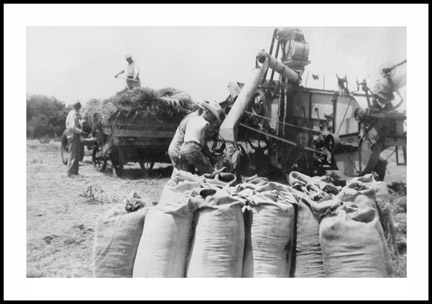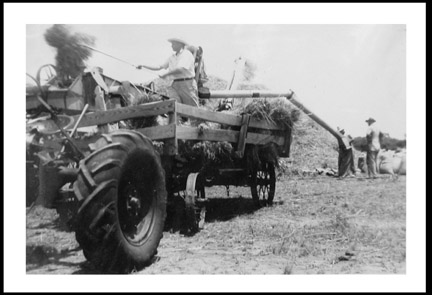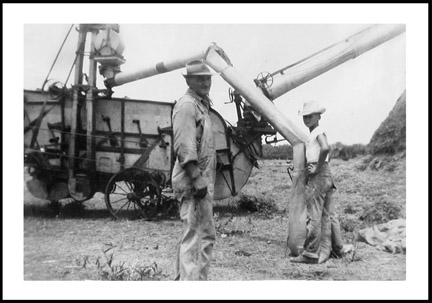Cranfills Gap
Bosque Co., Texas by Elroy Christenson

Thrashing wheat near Cranfills Gap,
Texas about 1949
photo Violet Christenson c1949

Thrashing wheat near Cranfills Gap,
Texas about 1949
photo Violet Christenson c1949
At one time thrashing wheat or sorgum was done like a "thrashing bee". Groups of farmers would come together to bring in the grain after it had been cut and bundled into shocks. The shocks would be picked up by wagons, in earlier years drawn by horses, but by the 1940's by gasoline powered tractors. These tractors also took the place of the steam engines that ran the thrashing machines by a 20 foot in diameter belt. The grain shocks would be off-loaded into the thrashing machines. The grain would be separated from the chaf by vibration and settle into a conveying system that could be caught in gunny sacks for later transportation to the barn and later sale for grinding into wheat flour.

My Dad on wagon tossing shocks of wheat into
the thrasher.
photo Violet Christenson c1949
The chaf would be blown out a large tube at the other end of the machine into a huge hay stack for cattle feed. The cows would eventually make tunnels into the stack where they could keep cool and eat to their hearts content. As kids we would play in these tunnels. They would eventually collapse as they ate away more and more material.
Even though my grandfather, Pete Christenson, had owned a couple
of thrashing machines during the 1920s they eventually became used
up and he also joined the cooperative spirit of the times.
The farmer typically would rent the machine and a few hands but
most of the help was provided by friends, neighbors and relatives.
Frequently there would be 20 to 30 men and about 5 to 7 women at
these "thrashing bees". They would range in age from
12 to 70 years of age. It mostly depended on the
person's own health and physical strength but the young were
urged to join in and do what they could. They knew that next
year the young men would be stronger. The men would work the
fields and the women would cook the food. The day would
start before sun up and a break would be taken during the heat of
the day about 2 to 3 o'clock. Work would stop at dusk or when
dampness made the grain too tough to thrash.
Late afternoon snack under a cedar tree. photo Violet Christenson c1949
Meals were served five times a day during the thrashing season so
the women were kept very busy providing food for the hungry
workers. Some of the women would be hired to follow
the crews from one farm to another. My aunts
Cora and Edith Johnson did this when they were younger
but later only got involved when the thrasher went to one of
the family members farms. All the associated kin would pitch
in and help to get the crops in before the rains fell.
One other thing they had to watch for was sleeping rattlesnakes in
the shocks of wheat. If they weren't careful one could be
picked up and thrown onto the wagon with a unsuspecting
stacker. This could spell disaster.

Grandpa Christenson and my
cousin, Darrel Reesing, sacking.
photo
Violet Christenson c1949
sources:
Pete
Christenson || Johnson/Rohne/Christenson
photo map
Egeberg/Johnson
lineage
map || Johnson
Family Index
Elroy's Family Index || Ancestor Chart #1






All information and
photos included within these pages was developed by
the help of hundreds of researchers. The information
here is for the express purpose of personal
genealogical research and is freely offered as long as
this site is listed as a source. It may not be
included or used for any commercial purpose or
included in any commercial site without the express
permission of Elroy Christenson. Copyright Elroy
Christenson 1998-2010.